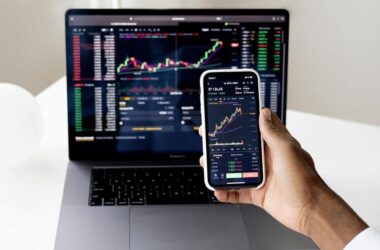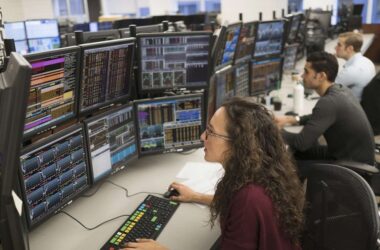The trading casualty count is brutal despite wielding advanced tools and research. This isn’t just a statistic – it’s a battlefield report from the financial front lines. Approximately 90% of stock market traders incur losses without a proper investment strategy.
Retail traders hemorrhaged over $1 billion through emotional decision-making and a lack of proper battle plans.The smart money skips the morning rush – traders who avoid the first 30 minutes see 3 percentage points higher capital gains than their early-bird counterparts.
Our intelligence gathering exposes alarming tactical failures. Between January 2020 and July 2021, 60% of traders globally fought without stop-loss shields. Only 44% of these unprotected traders managed to secure profits. The wounded abandoned positions quickly, and losing trades were closed 1.4 times more often within five minutes than winning ones.
In the trading war, amateurs face overwhelming firepower. We’ll expose why retail traders fight at a severe disadvantage, how trading platforms and market structures create kill zones, and identify the external forces that make consistent profits elusive for most day traders.
Retail Traders: Outgunned From The Start
Retail traders enter the battlefield severely outmatched. Unlike institutional giants commanding massive capital arsenals, individual investors fight with limited resources and firepower, creating an immediate strategic disadvantage.
Information asymmetry forms the first line of defense that they can’t breach. While Wall Street commands real-time intelligence and sophisticated reconnaissance, retail traders operate with. In volatile markets, even seconds matter – slight data lags become fatal. Retail troops make critical decisions using outdated intelligence, especially in options markets where real-time data costs prohibit access for individual soldiers.
The knowledge gap cripples their advance. Research confirms that many new traders openly admit to total confusion when handling complex weapons like options. This tactical ignorance triggers costly blunders:
- Overpaying for options based on misunderstood volatility metrics
- Suffering massive bid-ask spread casualties (9-10% of investment value)
- Holding losing positions after earnings announcements when the volatility advantage evaporates
These three fatal errors alone result in escalating to 10-14% during high-volatility earnings battles
The cost of war bleeds them dry. Retail traders pay higher commissions, wider spreads, and steeper fees than institutional competitors. Each trade starts underwater before the first market movement.
Modern trading platforms create an illusion of equal combat footing. The harsh reality? Most retail traders still fight without the technological armor that institutional traders deploy. While today’s platforms offer more weapons than before, mastering these tools demands specialized training [4]. Most troops struggle with the technical complexity of algorithmic systems that might otherwise level the killing field.
These structural disadvantages explain why retail traders suffer such devastating casualty rates despite democratized market access.
Trading Platforms: The Rigged Battlefield
Modern trading platforms look like weapons of financial freedom, but function as enemy agents. Robinhood and similar “gamified” investing apps promise zero-commission trades while silently extracting your capital through hidden kill switches.
These platforms deploy psychological warfare techniques—flashy animations, free stock bribes, and competitive leaderboards—designed to hijack your trading strategy. The research confirms the carnage: these features trigger more frequent trading and herd-like behavior, decimating returns. Gamified elements push traders into high-risk combat zones: excessive leverage, oversized positions, and volatile stocks.
High-frequency trading (HFT) firms ambush day traders with overwhelming firepower. Their algorithmic weapons execute trades in microseconds—a fight retail traders can’t win.Your losses are their victories.
When market volatility strikes, when you need cover fire, HFT traders retreat. They withdraw from the battlefield, slashing liquidity by 40% and widening spreads by ten basis points. The reinforcements vanish when the fighting gets tough.
Even the clock works against you. Tax return data reveals that traders with fewer waking market hours achieve better portfolio performance. Less time in the crossfire means fewer wounds to your capital.
The market structure favors elite forces with superior intelligence: trading desks, premium financial media, and battle-grade analytical software. For day traders, platform reliability equals survival—execution delays mean certain death for your positions. Transaction costs from frequent trading drain your ammunition reserves unless strictly controlled.
The trading arena isn’t a fair fight—it’s a rigged battlefield where institutional players with superior resources and technology systematically eliminate retail traders.
External Battlefronts: Forces That Crush Day Traders
These external forces decimate even the most disciplined retail warriors.
Social media serves as psychological warfare against trader discipline. Reddit’s r/wallstreetbets (WSB) battlefield creates pure chaos – research confirms this platform triggers uninformed trading and skyrockets risk levels. The casualties are devastating – WSB attention significantly slashes holding period returns.
Market volatility acts as a strategic bombing run on trader accounts. Despite claims of “opportunity,” volatility is primarily a weapon that destroys the unprepared. High-volatility stocks execute rapid price ambushes that obliterate trading accounts. When markets turn violent, high-frequency traders retreat from the field, draining liquidity by 40% and widening spreads by ten basis points. The professional forces evacuate precisely when retail traders need cover fire.
Pump-and-dump schemes operate as guerrilla warfare against retail troops. These tactical strikes spread through social media, encrypted messaging, and email campaigns. Small-cap stocks with minimal liquidity become perfect targets – prices inflate artificially before orchestrators cash out at maximum profit. First-time traders become cannon fodder, lacking combat experience to identify these coordinated assaults.
Herd mentality functions as mass panic in the trading trenches. Studies confirm investors caught in the stampede during market downturns typically panic-sell, destroying long-term performance. This mental weakness forces traders to buy high and sell low – a fatal tactical error.
Black swan events strike as financial nuclear bombs – rare, unstoppable, and catastrophic. Traditional risk defenses provide zero protection against these market-shattering events. The 2008 financial crisis proved that conventional defense systems utterly fail against such extreme attacks.
These combined enemy forces explain why 90% of day traders bleed out their accounts despite fighting their hardest battles.
The Final Battle Report
The war casualties are undeniable. Day trading remains a blood-soaked battlefield for retail investors. Despite tech advancements promising equal footing, 90% of day traders surrender their capital. The combination of tactical disadvantages, platform weaponization, and external enemy forces creates a killing field that decimates most retail participants.
The intelligence briefing is clear: victory demands more than just market access. Information warfare puts retail traders in compromised positions compared to institutional forces with premium reconnaissance capabilities. Trading platforms deploy psychological operations through gamification that trigger risky behavior instead of disciplined strategic planning. Meanwhile, high-frequency tactical units extract profits directly from retail trades, especially during market volatility when covering fire is most needed.
External threats like social media influence, market manipulation schemes, and herd mentality act as force multipliers against retail traders. The few who survive this battlefield represent a small elite squadron that employs strict risk management protocols, focuses on specific tactical engagements, and maintains emotional discipline under fire.
The hard truth from our frontline reports: most individuals would secure better strategic positions through long-term investment approaches rather than day trading skirmishes. The market battlefield heavily favors institutional armies with superior resources, leaving most retail day traders outgunned, outmaneuvered, and fighting a war they cannot win.
FAQs
Q1. Why do most day traders lose money? Most day traders lose money due to several factors, including information asymmetry, lack of proper tools and knowledge, high transaction costs, and the influence of market volatility. Additionally, the gamification of trading platforms often encourages risky behavior, leading to poor decision-making and financial losses.
Q2. What percentage of day traders are actually profitable? Research indicates that approximately 90% of day traders lose money. This means only about 10% of day traders manage to be consistently profitable. The high failure rate is attributed to various challenges such as market structure disadvantages, external pressures, and psychological factors affecting trading decisions.
Q3. How do trading platforms impact a day trader’s success? Trading platforms can significantly impact a day trader’s success, often not in their favor. Many platforms use gamification techniques that encourage frequent and risky trading. Additionally, the presence of high-frequency trading on these platforms can put individual traders at a disadvantage, as they cannot compete with the speed and sophistication of algorithmic trading systems.
Q4. What role does market volatility play in day trading outcomes? Market volatility presents a significant challenge for day traders. While some claim it creates opportunities, high volatility often leads to large and fast price swings that can quickly result in substantial losses for unprepared traders. During volatile periods, liquidity may also decrease, making it harder to execute trades effectively.
Q5. How can retail traders improve their chances of success? To improve their chances of success, retail traders should focus on developing a solid understanding of market dynamics, employing strict risk management strategies, and maintaining emotional discipline. It’s also crucial to be aware of the structural disadvantages they face and to approach trading with realistic expectations. Many experts suggest that for most individuals, long-term investment strategies may be more suitable than active day trading.






